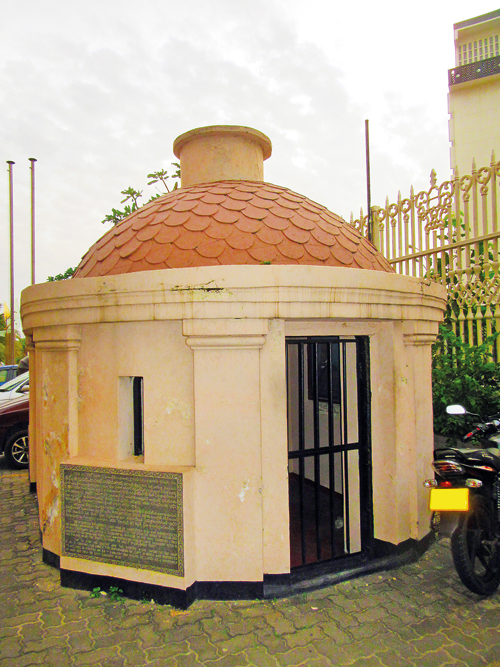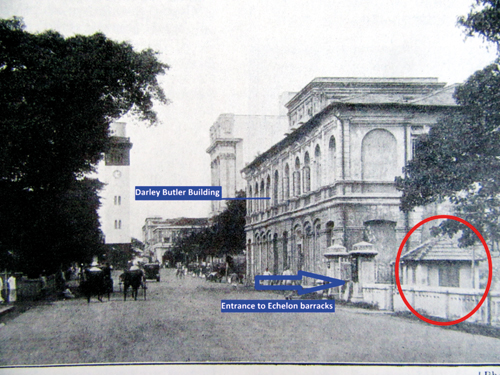Mystery over the last King’s ‘cell’ in Fort

The monument within the Ceylinco House premises
The prison cell of the last King of Kandy, King Sri Wickrama Rajasingha in Colombo Fort is a well-known monument situated within the premises of the Ceylinco House building down Janadipathi Mawatha (Queen’s Street) at the turn-off to Bank of Ceylon Mawatha. Although it is commonly known as the prison cell where the last King was kept, there appear to be two versions to this story–the commonly held belief and the more academic theory.
The popular story goes that the King was kept in a cell within the Fort of Colombo before his departure to India, but is that accurate? Was he imprisoned or placed under house arrest as said by some? King Sri Wickrama Rajasingha was captured by the British on February 18, 1815 in Medamahanuwara and transferred to Colombo. On March 6, the King and his escort entered the Colombo Fort where they were received by Colonel Kerr, the commandant of the garrison. Here the King remained for nearly a year till January 24, 1816 when he and his family were taken to Vellore aboard the HMS Cornwallis.
But, according to the Official Government Gazette and the writings of Dr. Henry Marshall, the King was kept in a house under house arrest, and not in a cell.To quote the Gazette No. 704, Wednesday, March 15, 1815:
“On the Monday following Major Hook with the Detachment under his command escorting the late King of Kandy and his family entered the Fort…He is lodged in a House in the Fort which has been suitably prepared for his reception and is stockaded round to prevent any intrusion on his privacy” .
This being an official Government document confirms the fact that the King was placed in a house specially prepared for him. Further the account of Dr. Henry Marshall too is to be noted here. In his celebrated work, ‘Ceylon: A general description of the island and its inhabitants with a historical sketch of the conquest of the colony by the English’ published in 1846 and reprinted in 1969, Dr. Marshall states that:
“… the prison or house provided for him was spacious, and handsomely fitted up. He was obviously well pleased with his new abode, and upon entering it, observed, “As I am no longer permitted to be a King, I am thankful for the kindness and attention which have been shown to me”.
So where did we go wrong? It is important to see the whereabouts of the said house. A brief study done by the writer, found only the reference from Dr. R. L. Brohier’s book, ‘Changing Face of Colombo’ indicating the location of the house. He states it to be a Dutch dwelling house, which was later occupied by the Darley Butler firm; this is the present site of the Ceylinco House, the location of the present monument. The fact that a Dutch house existed at this site is also confirmed by the book, ‘When the going gets tough, the tough gets going: a history of Ceylinco Insurance’.
An investigation into the location of this site from the maps of 1733 and 1756-59 from Comprehensive Atlas of the Dutch United East India Company Vol. IV Ceylon, reveals that the block along the Janadipathi Mawatha from Ceylinco House to the National Mutual Building (Center Point Building) was a residential area for officers of the Dutch East India Company. Thus it is clear that the present site of the Ceylinco House was the site of a Dutch house during the 1700s and would have most likely been there in 1815, which is just 19 years after the takeover of the Colombo Fort by the British.

A picture taken in the 1920-30s showing the guardroom
Then, what is the present monument? What was its function? When was it built? R. L. Brohier states in his Changing Face of Colombo: “The monument has no greater significance possibly than that of having been a sentry box set up at the gate-way to the adjoining garrison building erected by the British in 1875 (Echelon square buildings- now demolished)”.
Between the timeline of the Dutch house and the present Ceylinco building on this block, is another building, that of the Darley Butler building, and a map of 1904/5 of Colombo from the National Archives shows a small box-shaped structure just bordering the Darley Butler building to the south. A closer examination of it from a much clearer map of 1938 showed this particular structure within the boundary of the Echelon barracks. It appears to have been a guardroom as there is an entrance to the barracks just by it facing Queen’s Road.This can be clearly seen from a photograph from the 1920s/30sfrom the book, ‘Extract from Sea Ports of India and Ceylon’. When analysing the position of this guardroom and the present monument from the 1904/5 map, an aerial image of 1960 and a present satellite image in relation to the Darley Butler building and the Ceylinco House, it clearly shows that both the guardroom and the present monument are the same.
But then this brings us to another problem, the present monument looks totally different to the guardroom. This brings us to the conclusion that as both the guardroom and the present monument fit to the same location, there appears to have been a modification or complete remodelling effected to the guardroom by 1960, as a photograph taken from the Baur’s building in 1960 (in the book, ‘The Faithful Foreigner, Thilo Hoffmann’) shows the present monument with its prominent vaulted roof and ventilation duct.
Therefore it is possible to conclude that the present monument was indeed a guardroom of the Echelon barracks as stated by Dr. R. L. Brohier. As to why its appearance was changed and how it came to be known as the prison cell of the last King, we may never know. Somewhere down the line for political reasons or either, this claim was brought up and acted upon officially by the authorities; as this is a protected archaeological monument at present and contains the official Department of Archaeology description as well as a granite inscription stating the same.
It is therefore possible that the King was not kept in a cell and that the present monument belongs to a later period. This article aims at changing this public view, hence a humble request to all enthusiasts and tour operators – not to describe this site as the prison cell of King Sri WickramaRajasingha but rather a ‘monument’ to the last King of Sri Lanka at the site where he last stayed in the island before his departure to India.
For more on the monument by this writer please see www.archaeology.lk


